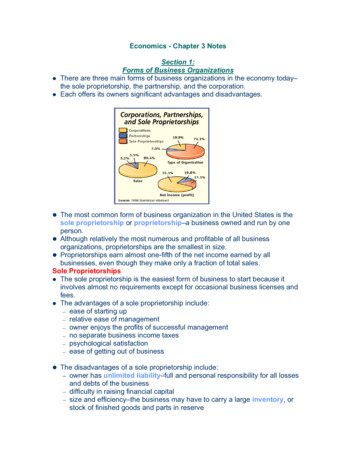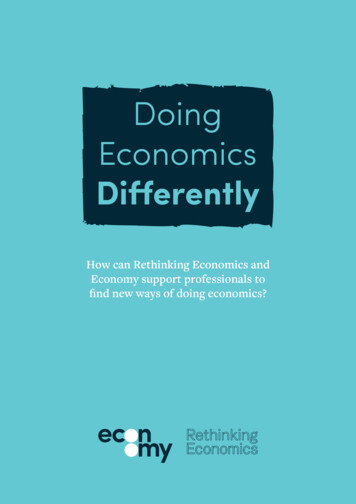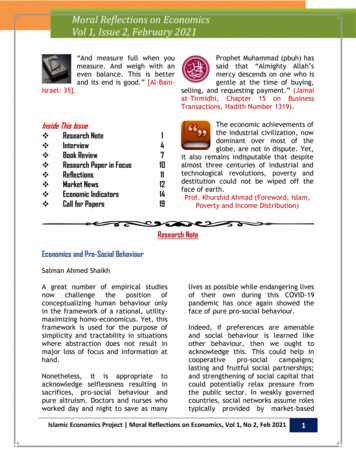
Transcription
Economics - Chapter 3 Notes Section 1:Forms of Business OrganizationsThere are three main forms of business organizations in the economy today–the sole proprietorship, the partnership, and the corporation.Each offers its owners significant advantages and disadvantages. The most common form of business organization in the United States is thesole proprietorship or proprietorship–a business owned and run by oneperson. Although relatively the most numerous and profitable of all businessorganizations, proprietorships are the smallest in size. Proprietorships earn almost one-fifth of the net income earned by allbusinesses, even though they make only a fraction of total sales.Sole Proprietorships The sole proprietorship is the easiest form of business to start because itinvolves almost no requirements except for occasional business licenses andfees. The advantages of a sole proprietorship include:– ease of starting up– relative ease of management– owner enjoys the profits of successful management– no separate business income taxes– psychological satisfaction– ease of getting out of business The disadvantages of a sole proprietorship include:owner has unlimited liability–full and personal responsibility for all lossesand debts of the business– difficulty in raising financial capital– size and efficiency–the business may have to carry a large inventory, orstock of finished goods and parts in reserve–
limited managerial experiencedifficulty of attracting qualified employeeslimited life–firm ceases to exist when owner dies, quits, or sells thebusinessPartnerships A partnership is a business jointly owned by two or more persons. Partnerships are the least numerous form of business organization, accountingfor the smallest proportion of sales and net income.–––Types of Partnerships The most common form of partnership is a general partnership, one in whichall partners are responsible for the management and financial obligations ofthe business. In a limited partnership, at least one partner is not active in the daily runningof the business, although he or she may have contributed funds to finance theoperation. Because more than one owner is involved, formal legal papers called articlesof partnership are usually drawn up to specify arrangements betweenpartners. The advantages of a partnership include:––––––ease of establishmentease of managementlack of special taxesattract financial capital easilyslightly larger size, increased efficiencyeasier to attract top talent The disadvantages of a partnership include:each partner is fully responsible for the acts of all other partnerslimited partners have limited liabilitylimited lifepotential for conflict between partnersoffer increased access to financial capital, but do not always work outA business may have to file for bankruptcy, a court-granted permission toan individual or business to cease or delay debt payments.Corporations Corporations account for approximately one-fifth of the firms in the UnitedStates and about 90 percent of all sales. A corporation is a form of business organization recognized by law as aseparate legal entity having all the rights of an individual.Forming a Corporation Unlike a sole proprietorship or partnership, a corporation is a very formal andlegalarrangement.––––––
People who would like to incorporate, or form a corporation, must file forpermission from the national government or the state where the business willhave its headquarters. If approved, a charter–a government document that gives permission tocreate a corporation–is granted.The charter also specifies the number of shares of stock, or ownershipcertificates in the firm. These shares aresold to investors,called stockholders or shareholders. The money is then used to set up the corporation. If the corporation is profitable, it may eventually issue a dividend–a checkrepresenting a portion of the corporate earnings–to each stockholder.Corporate Structure When an investor purchases stock, he or she becomes an owner with certainownership rights.
The advantages of a corporation include:– ease of raising financial capital– gain capital by selling additional stock– borrow money by issuing bonds A bond is a written promise to repay the amount borrowed at a later date. The amount borrowed is known as the principal. While the money is borrowed, the corporation pays interest, the price paid forthe use of another’s money. The advantages of a corporation also include:– professional managers run the firm– limited liability for owners– unlimited life– ease of transferring ownership The disadvantages of a corporation include:– difficulty and expense of getting a charter– owners have little say in how the businessis run– double taxation of corporate profits, stockholders’ dividends are taxedtwice–once as corporate profit and again as personal income– more government regulationBusiness Development State governments are very active in trying to attract new industry. Governors often travel throughout the country or even to foreign countries todraw new business to their states. A state may offer an incentive such as a tax credit, or a reduction in taxes, inreturn for the creation of new jobs or new business investment.Section 2:Business Growth and Expansion A business can grow in one of two ways. It can grow by reinvesting some of itsprofits. A business can also expand by engaging in a merger–a combination of two ormore businesses to form a single firm. Most businesses use some of the revenue they receive from sales to invest infactories, machinery, and new technologies. We can use the income statement–a report showing a business’s sales, expenses, and profits for a certain period–to illustrate the process.The business first records its total sales for the period.Next, it finds its netincome by subtractingall of its expenses, including taxes, from its revenues.These expenses include the cost of goods and depreciation, a non-cashcharge the firm takes for the general wear and tear on its capital goods.
Reinvesting Cash Flows Depreciation is called a non-cash charge because, unlike other expenses, themoney is never paid to anyone else. Cash flow, the sum of net income and non-cash charges such as depreciation,is the bottom line, or real measure of profits for the business. The cash flow represents the total amount of new funds the businessgenerates from operations. Business owners decide how the cash flow will be allocated. When cash flows are reinvested in the business, the firm can produceadditional products. As long as the firm remains profitable, and the reinvested cash flow is largerthan the wear and tear on the equipment, the firm will grow.Growth Through Mergers When firms merge, one gives up its separate legal identity. The name of the new company may reflect the identities of the mergedcompanies.– A firm may seek a merger to grow faster, to become more efficient, toacquire or deliver a better product, to eliminate a rival, or to change itsimage.– Some companies merge in order to grow faster.– Efficiency is another reason for mergers.– Some mergers are driven by the need to acquire new product lines.– Sometimes firms merge to catch up with, or even eliminate, their rivals.– A company may use a merger to lose its corporate identity.
Types of Mergers Economists generally recognize two types of mergers:– The first is ahorizontal merger, whichtakes place when two ormore firms that produce thesame kind of product joinforces.– When firms involved indifferent steps of manufacturing or marketingjoin together, it is a vertical merger. A corporation may become so large through mergers and acquisitions that itbecomes a conglomerate.A conglomerate is a firm that has at leastfour businesses, each making unrelatedproducts, none of which is responsiblefor a majority of its sales.Other large corporations have become international in scope.A multinational is a corporation that has manufacturing or service operationsin a number of different countries.They are important because they have the ability to move resources, goods,services, and financial capital across national borders.Section 3:Other OrganizationsMost businesses use scarce resources to produce goods and services inhopes of earning a profit for their owners.Other organizations operate on a “not-for-profit” basis.A nonprofit organization operates in a businesslike way to promote thecollective interests of its members rather than to seek financial gain for itsowners.Examples of nonprofit institutions include organizations such as schools,churches, hospitals, welfare groups, and adoption agencies.Most of these organizations are legally incorporated to take advantage ofunlimited life and limited liability.They are similar to profit-seeking businesses, but do not issue stock, paydividends, or pay income taxes.They use scarce factors of production to serve many needs.
CooperativesTypes of CO-OP’S Consumer cooperative:– The consumer cooperative is a voluntary association that buys bulkamounts of goods such as food and clothing on behalf of its members. Service cooperative:– A service cooperative provides services such as insurance, credit, andbaby-sitting to its members, rather than goods.(Ex. Credit Union) Producer cooperative:– A producer cooperative helps members promote or sell their products.Labor UnionsProfessional Associations Many workers belong to professional societies, trade associations, oracademies. One such organization is a professional association–a group of people in aspecialized occupation that works to improve the working conditions, skilllevels, and public perceptions of the profession. These associations also seek to influence government policy on issues thatare important to them.Business Associations Businesses also organize to promote their collective interests. Most cities and towns have a chamber of commerce that promotes thewelfare of its members and of the community. Many business organizations represent specific kinds of businesses and arecalled industry or trade associations. Some business associations help protect the consumer. The Better Business Bureau, a nonprofit organization sponsored by localbusinesses to provide general information on companies, is one of these.Government Direct Role of Government:– Many government agencies produce and distribute goods and services toconsumers, giving government a direct role in the economy.– The role is “direct” because the government supplies a good or service thatcompetes with private businesses.– Many federal agencies are organized as government-owned corporations.Government Indirect Role of Government:– The government plays an indirect role when it acts as an umpire to makesure the market economy operates smoothly and efficiently.– One such case is the regulation of public utilities, investor- or municipalowned companies that offer important products to the public, such as wateror electric service.– The government also plays an indirect role when it grants money to peoplein the form of Social Security, veterans’ benefits, financial aid, andunemployment compensation.
Economics - Chapter 3 Notes Section 1: Forms of Business Organizations There are three main forms of business organizations in the economy today– the sole proprietorship, the partnership, and the corporation. Each offers its owners significant advantages and disadvantages. The most common











